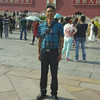Located in the northeast suburb of Linxia City. Zhuang Yigong Wang Qian (1413~ 1488), the word Gongdu, the number, the ancestral nationality of Hubei Jiangxia, his grandfather Wang Junqing Qianbian, with the nationality of Linxia City. The Ming Dynasty was known as the "Great Man of the World, the Heavy Prince of the Country", "The Eternal People, the Baishi Hengjian". Many later people called it "Wang Shangshu". It is a clean official, straight, patriotic and loving people, and pushes for reform. Because of Huaicai, it is not encountered. It is approved to resign from the hometown of the official. After returning to Hezhou, the court asked him to go out many times, and he was politely rejected. He lived at home for 23 years, operated Tian Yu, taught his children to read, and filled in words and chanted poetry. Wang Shang's book and poems include "The Collection" and "The Rest Collection". In the first year of Yuanzhi, on the third day of the early December of the lunar calendar in 1488, Wang Shangshu died of illness and was buried in the northeast suburb of Linxia City. The court pursued the gift as a prince and a statue of the prince, and the statue of the king was "strong and persevering". To the liberation of the fashion remnants of the "shangshu tomb", which was destroyed during the Cultural Revolution. It has been reconstructed and consists of hemispheric burial chambers, Shi Wengzhong, Shima, Shihu, Shiyang and Wangzhu.
;
Tomb of Minister Wang Review
5 /54 Reviews






5/5
Tomb of Minister Wang
Posted: Nov 27, 2016


3 person liked this
Like
Recommended Attractions at Popular Destinations
Bangkok attraction near me | Tokyo attraction near me | Manila attraction near me | Hong Kong attraction near me | Taipei attraction near me | Seoul attraction near me | Los Angeles attraction near me | New York attraction near me | Shanghai attraction near me | Kuala Lumpur attraction near me | Shenzhen attraction near me | Osaka attraction near me | Singapore attraction near me | London attraction near me | Guangzhou attraction near me | San Francisco attraction near me | Beijing attraction near me | Macau attraction near me | Bali attraction near me | Paris attraction near me | Ho Chi Minh City attraction near me | Orlando attraction near me | Jakarta attraction near me | Chicago attraction near me | Phuket attraction near me | Toronto attraction near me | Istanbul attraction near me | Dallas attraction near me | Cebu attraction near me | Seattle attraction near me
Popular Attractions
Mutianyu Great Wall | Akihabara Electric Town | Te Puia - Rotorua, NZ | Fu Rong Guo Cui - Legend of Face Changing | The Temple of the Emerald Buddha | Gold Coast Sea World | Wundermanufaktur | Ocean Park Hong Kong | Universal Beijing Resort | Onsen Hot Pools | Shanghai Film Museum | Baijiahu Museum | Meiguan Ancient Post Road | Stelios Kyriakides Stadium | Sky Waka Gondola | Gongqing National Forest Park | Mochou Lake Park | Yu Garden | Sevgi Bahçe | Limones | Safa garden | Achiaa Memorial Park | Hanjiang Bridge | Durga Mandir,Near Gulab School Bijuri | Ecomuseu Vezeira e a Serra | Çocuk Parkı | Park C-Block | Park and Playground | Dreamworld | Shangxiajiu Pedestrian Street
Payment Methods
Our Partners
Copyright © 2024 Trip.com Travel Singapore Pte. Ltd. All rights reserved
Site Operator: Trip.com Travel Singapore Pte. Ltd.
Site Operator: Trip.com Travel Singapore Pte. Ltd.